- News
- Reviews
- Bikes
- Accessories
- Accessories - misc
- Computer mounts
- Bags
- Bar ends
- Bike bags & cases
- Bottle cages
- Bottles
- Cameras
- Car racks
- Child seats
- Computers
- Glasses
- GPS units
- Helmets
- Lights - front
- Lights - rear
- Lights - sets
- Locks
- Mirrors
- Mudguards
- Racks
- Pumps & CO2 inflators
- Puncture kits
- Reflectives
- Smart watches
- Stands and racks
- Trailers
- Clothing
- Components
- Bar tape & grips
- Bottom brackets
- Brake & gear cables
- Brake & STI levers
- Brake pads & spares
- Brakes
- Cassettes & freewheels
- Chains
- Chainsets & chainrings
- Derailleurs - front
- Derailleurs - rear
- Forks
- Gear levers & shifters
- Groupsets
- Handlebars & extensions
- Headsets
- Hubs
- Inner tubes
- Pedals
- Quick releases & skewers
- Saddles
- Seatposts
- Stems
- Wheels
- Tyres
- Health, fitness and nutrition
- Tools and workshop
- Miscellaneous
- Buyers Guides
- Features
- Forum
- Recommends
- Podcast
TECH NEWS
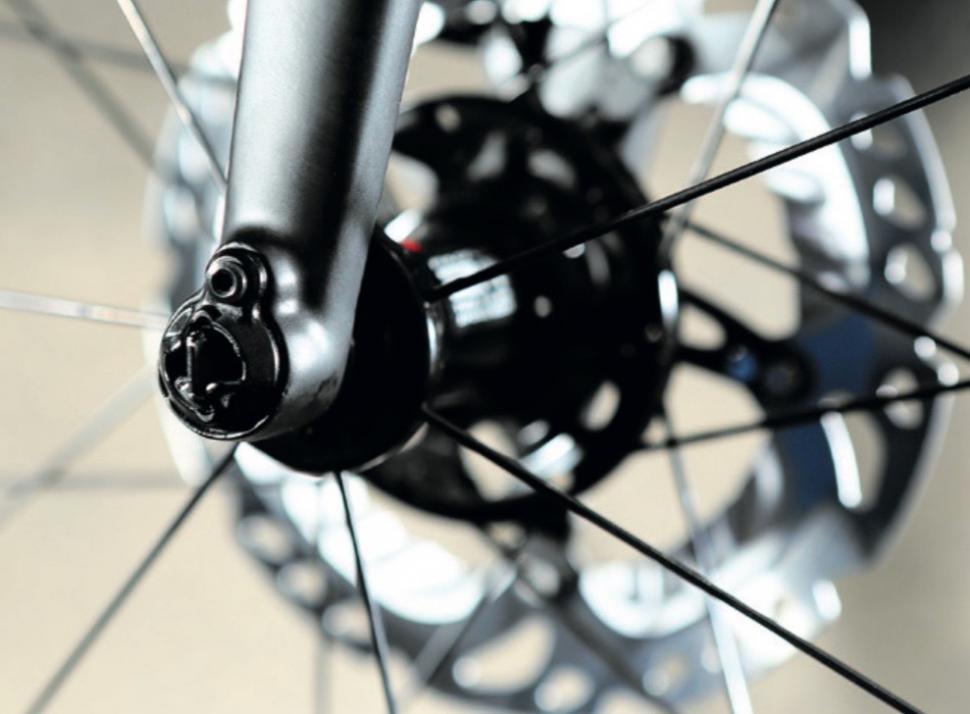 Merida Scultura Disc 2016 launch - 4.jpg
Merida Scultura Disc 2016 launch - 4.jpgHave disc brakes really led to injuries in peloton?
The UCI has suspended the trial of disc brakes in the pro peloton but is there any solid evidence to back up the claims that disc rotors have been responsible for any injuries?
Rather than simply accepting the claims that have been bandied about, let's examine them.
Movistar’s Fran Ventoso is at the centre of the controversy following an injury in Sunday’s Paris-Roubaix.
In a statement he said:
“Let me take you to 130km into the race: into a cobbled section, a pile-up splits the field, with riders falling everywhere. I’ve got to brake but I can’t avoid crashing against the rider in front of me, who was also trying not to hit the ones ahead. I didn’t actually fall down: it was only my leg touching the back of his bike.
“I keep riding. But shortly afterwards, I have a glance at that leg: it doesn’t hurt, there’s not a lot of blood covering it, but I can clearly see part of the periosteum, the membrane or surface that covers my tibia.
“I get off my bike, throw myself against the right-hand side of the road over the grass, cover my face with my hands in shock and disbelief, start to feel sick… I could only wait for my team car and the ambulance, while a lot of things come through my mind.
“15km after my incident, Nikolas Maes, a rider from Etixx-Quick Step, comes into the very same ambulance I’m sitting in. There’s a deep wound in his knee, produced by another disc.”
Let’s deal with the Nikolas Maes incident first because we can debunk that one straight away. Here are photographs of the crash that led to Maes abandoning the race.
You can see Maes in the white helmet in the centre of the shot still upright as Orica GreenEdge’s Mitchell Docker hits the ground. The black bike with green bar tape falling over is Docker’s. It's a Scott without disc brakes.
Two teams racing Paris-Roubaix were using disc brakes: Lampre-Merida and Direct Energie.
We have many shots of this incident. As well as Orica GreenEdge and Etixx-Quick-Step, our pictures show riders from IAM Cycling, Lotto Jumbo, AG2R, Astana, FDJ, Trek Segafredo, Katusha, Wanty - Groupe Gobert, Bora-Argon, Fortuneo - Vital Concept, Cannondale, Tinkoff, Lotto-Soudal, Delko Marseille Provence KTM, Cofidis, Dimension Data, and Topsport Vlaanderen-Baloise – the vast majority of teams in the race – but none from Lampre-Merida or Direct Energie.
Here’s Maes landing on his right knee (above) behind a Lotto Jumbo rider.
And here’s Maes’ injury to his right knee (above, far left of the picture).
I've just filmed this shocking incident of the motorbike rider careering in Viviani at #ParisRoubaix @TeamSky pic.twitter.com/pGPFmRfFvf
— Guy Wolstencroft (@r8uge) April 10, 2016
And here’s a video shot by Guy Wolstencroft showing the incident from another angle.
See any Lampre-Merida or Direct Energie riders close to Maes?
Unless Maes was involved in an incident prior to this one, his injury wasn’t caused by a disc brake rotor.
What about the claim that Fran Ventoso’s own injury was caused by a disc rotor?
Ventoso’s injury is on the front of his left leg, on the outer side. It must be difficult to get a disc brake injury here if your own bike isn’t fitted with discs and you haven’t come off – not impossible, but difficult. If the injury was to his right leg you’d have an easier time understanding it, disc brakes being fitted to the non-driveside of bikes. Still, strange things happen in crashes.
Ventoso didn’t see a disc brake cause his injury or realise it in the immediate aftermath of the crash, he only came to the conclusion that a rotor was responsible once he was underway again.
Maybe he’s right – he could well be – but the evidence seems far from conclusive. Ventoso obviously believes he was injured by a disc rotor, but we don't have to accept that without question. The rider has been hurt and our sympathies go out to him, but that doesn't mean he is necessarily right.
People have been voicing safety concerns about disc brakes in the pro peloton ever since their introduction was first suggested. These have usually been based on the ability of a rotor to cut and the different stopping abilities of riders running disc brakes while others are using rim brakes.
It’s interesting that the UCI decided to go ahead with the disc brake trial despite those concerns and has apparently decided to suspend that trial based on evidence that’s some way short of categorical.
What next? The UCI has now officially suspended the disc brake trial but the World Federation of the Sporting Goods Industry (WFSGI), representing the bike industry (or at least a large part of it) insists that discs are still very much part of the future of road racing.
Read what the UCI and the WFSGI have said here. 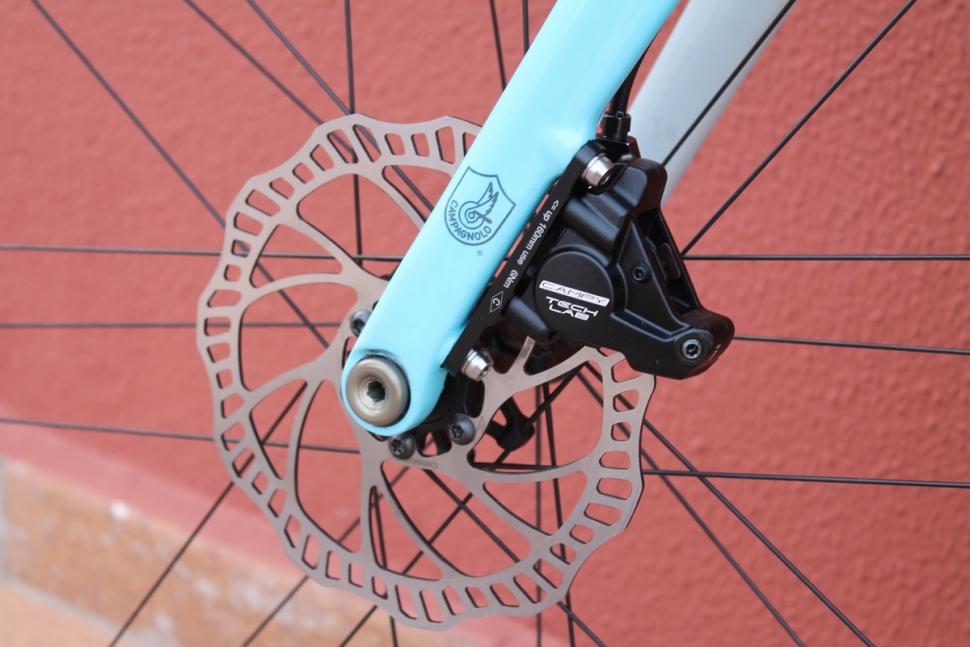
When Campagnolo revealed its new disc brakes last month we reported the brand’s marketing and communication director Lorenzo Taxis as saying, “Professional teams are not pushing for disc brakes, so let’s see what happens in the race season.”
Sean Kelly told us the same thing at a Vitus product launch earlier in the year, and we’ve heard similar from numerous current professionals.
In the aftermath of Paris-Roubaix several pro riders have reiterated that they're opposed to the use of disc brakes in the peloton.
We as riders should have a voice and a choice. Open letter: Fran Ventoso - https://t.co/0SwxPl8FO9 via @Movistar_Team
— Rory Sutherland (@rorysutherland1) April 13, 2016
Much of the bike industry, on the other hand, is keen for disc brakes to be used by the pros. The big races serve as a shop window for their products, after all. It'll be interesting to see how things develop.
What do you think? Over to you.
Mat has been in cycling media since 1996, on titles including BikeRadar, Total Bike, Total Mountain Bike, What Mountain Bike and Mountain Biking UK, and he has been editor of 220 Triathlon and Cycling Plus. Mat has been road.cc technical editor for over a decade, testing bikes, fettling the latest kit, and trying out the most up-to-the-minute clothing. We send him off around the world to get all the news from launches and shows too. He has won his category in Ironman UK 70.3 and finished on the podium in both marathons he has run. Mat is a Cambridge graduate who did a post-grad in magazine journalism, and he is a winner of the Cycling Media Award for Specialist Online Writer. Now over 50, he's riding road and gravel bikes most days for fun and fitness rather than training for competitions.
Latest Comments
- ktache 3 hours 11 min ago
The small frame, the aggressive posture, lots of standover height.
- mctrials23 4 hours 7 min ago
As i've said before, the police should be sued for a lot of money when someone they have knowingly ignored has gone on to commit a serious crime....
- David9694 4 hours 15 min ago
'Bad parking' blocks firefighters multiple times on same emergency call-out...
- David9694 4 hours 18 min ago
Cambridgeshire boy, 13, crashes Audi into garden wall after taking it from home...
- Adam Sutton 5 hours 4 min ago
Good stuff. Now do it on cycleway C9 through Hammersmith to Chiswick.
- mark1a 5 hours 13 min ago
It's technically allowed but it's not known as "London's Orbital Car Park" for nothing.
- Dogless 6 hours 21 min ago
You're defending bombing hospitals and refugee camps and starving children.
- mattw 9 hours 1 min ago
Used car salesman is a complete attention-seeking plank....
- tubasti 9 hours 18 min ago
I don't know if they're any better, but they's certainly become more boring.
- FionaJJ 9 hours 45 min ago
At risk of being cynical, and stereotyping the police, it's so they don't have to leave the comfort of their panda cars and pursue on foot when...
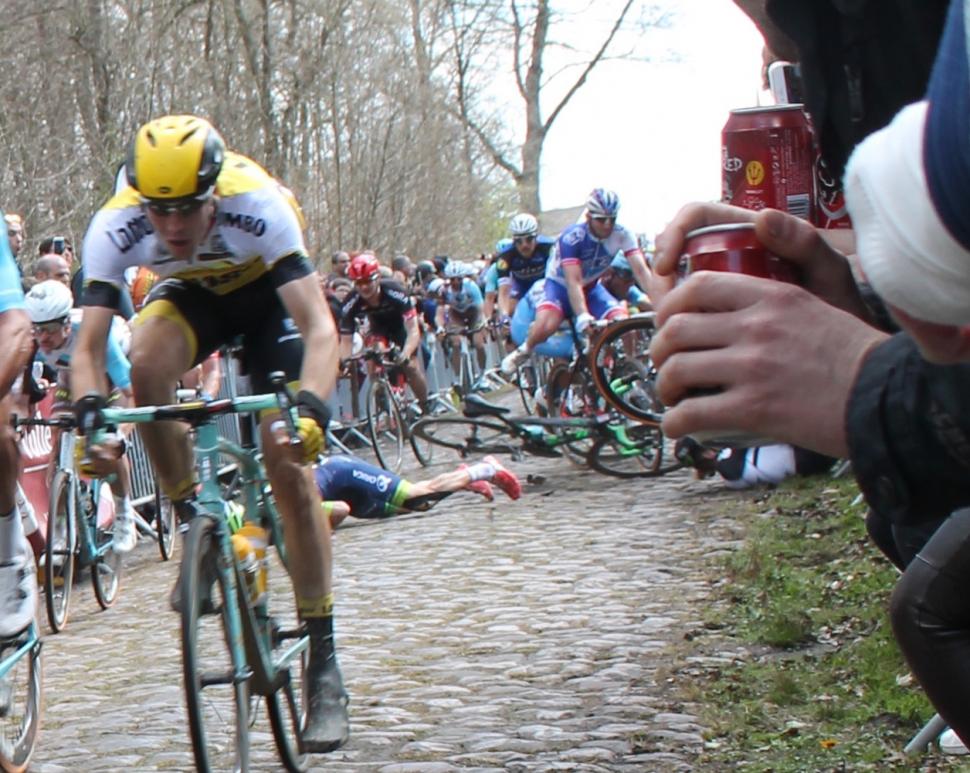
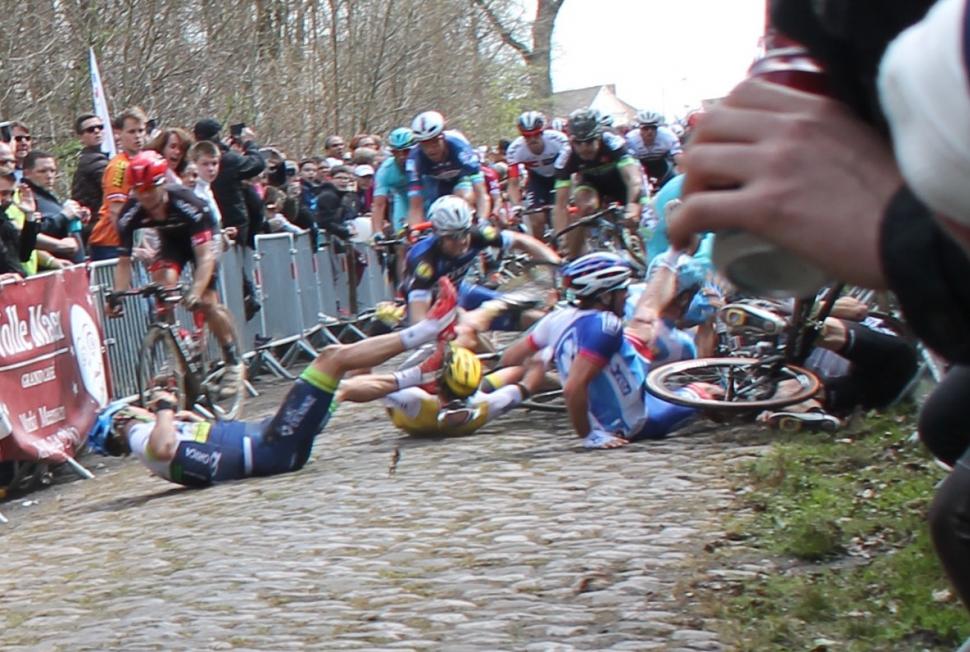
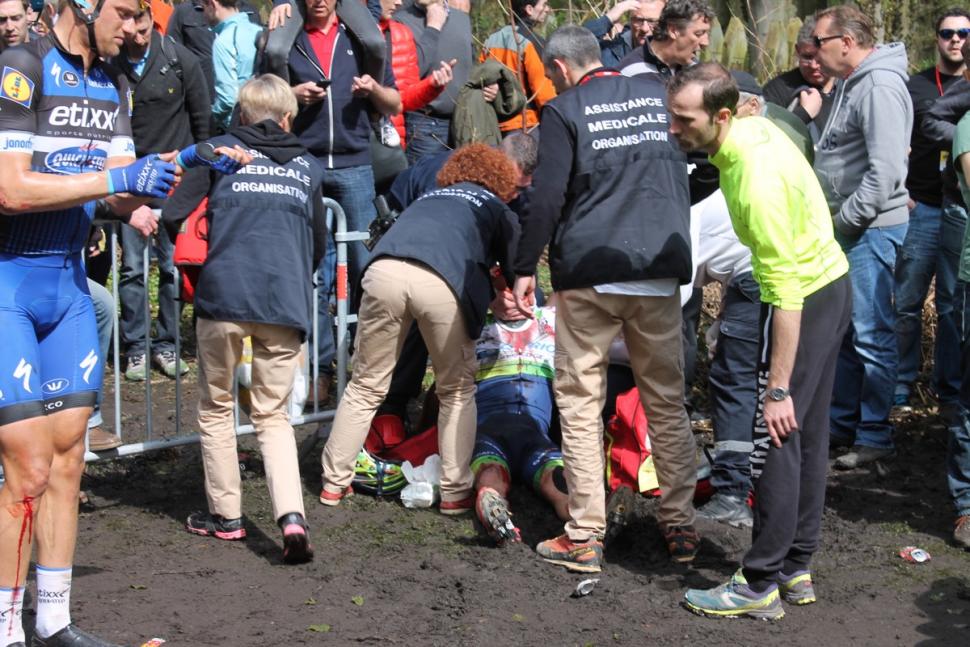

Add new comment
55 comments
Having worked as a paramedic for a number of years and looking at the injury, though on a slight off angle, the cut looks more like a laceration rather than an incision. Disc brakes would cut in a very precise, straight line. From this picture it looks like trauma second to blunt force since the cut seems irregular along it's edge. We would see this in a car accident where a head an arm etc, is thrown into a windshield and torn open, often to the bone. A disc brake would either slice it perfectly straight down or slice a piece of tissure off like a meat cutter. It's hard to know what he hit but just the force of a knee plowing into the ground or whatever could create a similar injury.
Given that sock related injuries account for some 12,000 A&E attendances and average 10 fatalities a year in the UK, there must now be enough disc brake equipped bicycles around for someone to have had a bona fide disc related injury. Because it would appear to me from the evidence so far that no pro peloton rider has.
So;
1. Has anyone here actually had first hand experience of a genuine disc brake related injury in a race or indeed any situation?
2. On the other side of the coin, do any disc brake users have a credible "disc brake saved my life when a rim brake wouldn't have" anecdote? (I don't by the way).
Biased judgement or not, sharp rotor are not really a necessity. The edges could be milled to be blunt. The sharp edges occur because the aluminium sheeting is cut with a laser, as it is very cheap. Pro level could absorb the cost of higher cost rotors. The bike industry would probably make more money with two price levels of rotors, rounded and not rounded. Especially if rounded becomes required for amateur racing.
The problem is that chainrings so far cannot be removed from road bikes and still have a functional bike. They also are about 50%+ covered/protected by the chain. You are correct, chainrings and uncovered drive trains are indeed dangerous, and that's why we don't need ADDITIONAL cutting surfaces like disc brakes added to the bike for little or no benefit. Disc brakes are not a required technology for bicycle operation. Modern direct mount rim brakes perform very well, but won't stop a wheel as fast as a disc brake in wet conditions. It should be noted that almost all disc brakes on other vehicles use anti-lock technology primarily for wet conditions. This is to prevent the tire from skidding. On a light vehicle or bike this problem is even worse. Rim brakes already have the ability to lock up the wheel, but assuming a reasonably skilled operator not so quickly as to put the bike in a skid in wet conditions, and they rarely grab.
However, if disc brakes without anti-lock MUST be used then the manufacturers owe it to us to provide more than a warmed over design copied from 1960s motorcycle technology. Motorcycle brakes are several millimeters wide however, and don't have sharp edges. I think it would be relatively easy for the manufacturers of disc brakes to provide a brake with a lightweight fully round 1/8 inch slick bead on the outside edge of the disc so it won't cut the riders. A self closing cam opening device could be made to close automatically when the disc is inserted into the brake. This would not fully protect a rider from a hot brake, but might provide a small amount of protection from heat as well. There may be other ways to provide a better margin of safety as well, and as an ex-engineer, I can think of a couple more I don't have time to detail. That's why there's a disc brake trial period, so these type of issues can be addressed. We don't have to give the bike industry carte blanche on safety so they can make a profit . If they want to sell products, someone should ensure they're safe. If they complain too much about UCI, perhaps the US Consumer Product Safety Commission should get involved, but if they do, bikes could come under a great deal of scrutiny none of the manufacturers are prepared for. Better that for the exorbitant prices they intend to charge for these Rube Goldbergs that they expend a little money and engineering on the safety and BTW light weight most Pro's want. Note that professionals typically are not the fussiest people about safety, so the average consumer should really consider what they say when they think a product is unsafe and tell you it sucks.
You are putting the cart before the horse. Manufacturers aren't going to spend money on R&D unless they think know they can sell product. The UCI's position - to the extent that it affects market penetration for disc brake equipped bikes among non-professional road cyclists - will delay improvements.
UCI to ban internal cables
12987167_10153393544716898_7100835172512149358_n copy.jpg
I think Ventoso, stating that Maes has an injury caused by 'another disc', indicates to me that there will be lots of 'assumption' that disc are to be blamed for everything. The evidence above tells me that Maes' injury was just caused by hitting the cobbles. But they'll blame discs because it's the hot topic atm.
Cobbled sections are slippery when wet (and dry!) and many a nasty accident has been had on them. Perhaps the UCI should ban cobbled sections if they want a reduction in injuries? And to think they've banned the disc trials with 'immediate effect' as rider safety is paramount....pfffft
It seems to be a bit horses for courses here. The pro teams don't feel the need for disc brakes. It just complicates the mechanics, wheel changing etc. And the riders are happy enough with rim brakes. This makes sense. Their bikes are cleaned every day so their brakes are always in great condition.
For the average commuting or weekend cyclist, who doesn't clean their bike that often then discs make total sense. Everyone knows how badly scored rims get after a winter of commuting - and how ineffective rim brakes can become in the wet.
The manufacturers are left in an unenviable position though. Obviously their customers are influenced a lot by what they see the pros using - and if the pros aren't using discs then they might be less keen to make the upgrade to discs.
Could a fairing be the answer to all this? I am sure that a lightweight affair can be easily produced in carbon fibre to keep spinning rotors from fragile flesh.
It would have to be a 2 part affair to suround the disc, slowing down wheel changes, and wouldn't be UCI legal
Great idea, I've seen them on recumbents and they are much faster too, no more sticking out bits anywhere
images.jpg
How many riders have definitely been injured due to the erratic performance of carbon rims and rim brakes? Tubs rolling off the rim? Personally I'd prefer the risk of a slice by a disk rotor than the thought of disappearing over the edge of a mountain pass as my/someone else's carbon rims braked erratically with rim brakes.
Just a thought.
Others are now coming forward with disc brake injuries, and some people are going to get sued soon
http://www.ukcyclocross.co.uk/articles/news/action-man-scar-caused-disc-brake-injury/
Why don't the uci ban chain rings or require a chain guard to be mandatory.. Muppets..
Because 90% of the time the chain is on the big ring - so its hard to get jabbed by it.
Also chainsets dont carry on spinning unlike discs.
Doesn't need to be spinning - ditto cassettes and other bits of lumpy metal, even discs. All it needs is one of you to have a bit of velocity compared to the other, and not much velocity for chainset or cassette believe me.
Whether they spin or not is completely irrelevent as it doesn't make them sharper. Plus they can only spin if entire wheel is spinning as they are not independent rotating masses. Bike wheels tend to stop turning when a bike stops, so again point doubly not relevent.
Becaue the chainring is invariably covered by the chain and in so doing, by the way, has about 2.5 times the width of a disc.
Invariably? So the small chain ring and the front mech on all the bikes is there purely for ballast to meet the UCI minimum weight then?
I'm sure I could think of cheaper ways to add 150 grams or so.
Also the cassette occupies a near identical position to the disc is just as likely to be spinning and the chain is rarely on the largest or second largest sprocket.
But actually they are not completely covered by the chain. If the pedal is in the forward position, the large chain ring is still exposed on the backside - could easily land on the that portion. The other is if the chain is on the small ring at the time of the crash then the large ring is completely exposed.
Becaue the chainring is invariably covered by the chain and in so doing, by the way, has about 2.5 times the width of a disc.
Why don't they just modify the brake unit to pull the brake shoe closer to the hub and cover the exposed edge of the disk with a thin rubber coating or something similar.
Like a mobile phone bumper style case.
I say ban Motorbikes and cars that follow the cyclists. Afterall they have killed and injured cyclists.
I think it is just stupid.
Yeah pretty hard to run a race with no team cars, commisaires, press following.
Hmm.
I think the left leg / right leg thing could be a bit of a red herring. Crashes are funny things and with limbs/bikes going everywhere (well, not precisely everywhere, but you know what I mean), you can end up with some unexpected injuries.
I still have some (now very faint) gouges on the inside-front of my LEFT shin, which were made by my chainring when I had a fairly big crash a few years ago (bike failure - thankfully no-one else involved). Yes, it was definitely the chainring - I remember cleaning up the black oily chainring tooth shapes that were printed on my leg.
I still can't work out how my left leg could make such contact with the chainring on the other side of my bike.
Still, really great that road.cc is questioning this point. While I am not at all convinced about the need for disc brakes on pro road bikes for the most part, I agree that such a strong decision made with no firm evidence is not necessarily the right way forward.
But according to Ventoso bikes weren't going everywhere. He was upright and on his bike, the bike he supposedly hit was upright with the rider on it, neither of them went down (or even fully stopped?).
Ah! Sorry, I missed that bit - was being a bit too hasty yesterday. I stand corrected.
On the face of it, that does seem rather perculiar.
Quite. He'd have had to have been unclipped and got his leg into a weird position round someone else's wheel to have got the injury. Weird things happen, but given the other holes in his tale (eg Maes not being anywhere near a rider with discs) it kind of looks like someone- indeed, given some private conversations I've had, an entire team organisation- that just doesn't like disc brakes and is borderline fabricating tales to pin injuries on them deliberately.
And as for the comments on todays articles, it reads like a moon landings conspiracy forum
I'm getting a bit bored of the road.cc obsession with disc brakes. I can't remember the last bike review on here that wasn't all about discs. And every second article seems to be about gravel bikes(?), discs or wide tyres. These are all things invented pretty much purely to sell bikes. Between this, click-bait articles and endless reporting of the dangers of cycling I think I'm off.
I realise a lot of people have disc brakes on the road and are very happy. Me, I'll stick with being able to swap wheels between bikes, not having to throw the frame away because I bought a Betamax axle system, riding nice wheels and braking a bit more gently in the wet.
Pages